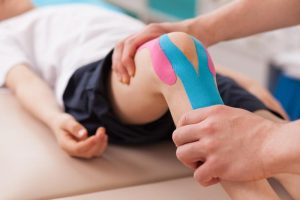
Kinesio tape is latex-free and hypoallergenic which makes it “skin friendly” for patients with sensitive or fragile skin such as patients with diabetes, fibromyalgia or rheumatoid arthritis. You can wear it for multiple days at a time. Because it is heat-activated, you can even wear it in the shower or pool without it peeling off. It is safe for patients of multiple age groups ranging from pediatric to geriatric, and it successfully treats a variety of orthopedic, neuromuscular, neurological and other medical conditions. Kinesiology Taping is a therapeutic taping technique that not only offers patients the support they are looking for, but also provides rehabilitation. By targeting different receptors within the somatosensory system, kinesiology tape alleviates pain and facilitates lymphatic drainage by microscopically lifting the skin. This lifting affect forms convolutions in the skin thus increasing interstitial space and allowing for a decrease in inflammation of the affected areas.
Although it contains no medications or topical substances, kinesiology tape can effectively relieve both acute and chronic pain. Its elasticity lifts the skin slightly, which immediately reduces pressure on sensitive pain receptors under the skin. In addition, its stimulating effect on pain pathways provides a competitive stimulus that blocks pain signals going to the brain. This is especially effective for pain from “hot” injuries, where the intensity of the pain is out of proportion to the severity of the injury.
In addition to the nonmedical properties of K-tape, one of the most dramatic effects of kinesiology taping is the removal of blood that accumulates under the skin due to bruising. The k-tape is applied in a fan pattern over the bruised area and the bruising is dissipated via the same lifting mechanism described above. Within a couple of days, a distinct fan pattern can be seen where the tape was applied over a bruised area.
Lastly, certain neurological or muscular disorders can make muscles so weak that it is almost impossible to do the exercises that are critical to improving daily functioning. Kinesiology tape not only provides support to these muscles but can also improve muscle activation, allowing therapeutic exercises to be carried out more effectively. One of the major uses in this category is with infants and young children with hypotonia, poor muscle tone that limits their ability to learn to sit up, crawl, etc. A simple application of kinesiology tape can improve posture and assist in mobility.
Yes, the science behind k-tape is very sound. It’s roughly a 40 year old practice at this point, but has gained a lot of hype in the past decade. This hype is justified, and from a scientific standpoint here is what k-tape is designed to do:
Supporting the muscle — Proper taping improves the muscle’s ability to contract even when it’s weakened, reduces a feeling of pain and fatigue, and protects the muscle from cramping, over-extension and over-contraction.
Removing congestion to the flow of body fluids — Kinesiology tape improves blood and lymphatic circulation and reduces inflammation and excess chemical buildup in the tissue.
Activating the endogenous analgesic system — “Endogenous” refers to something that is self-originating, and calling something “analgesic” means that it can relieve pain in a conscious person. So, this requirement means that the tape must facilitate the body’s own healing mechanisms, a central focus in chiropractic medicine.
Correcting joint problems — The goal is improving range of motion and adjusting misalignments that result from tightened muscles.
Dr. T will recommend any and all methods that lead to better performance or function in your life. If he thinks k-tape may help during certain activities or to relieve some discomfort – he will absolutely let you know.
TUESDAY: 10:00AM – 7:30PM
WEDNESDAY: 7:00AM - 5:00PM
THURSDAY: 10AM - 7:30PM
FRIDAY: 8AM - 2:00PM
SATURDAY: 7:00AM – 11AM
IN MOTION CHIROPRACTIC AND REHABILITATION
PRIVACY POLICY | SITEMAP | ACCESSIBILITY | WEBSITE BY AIO BRANDING
